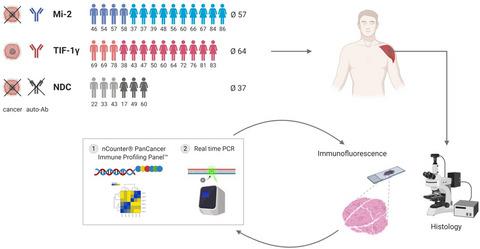当前位置:
X-MOL 学术
›
Brain Pathol.
›
论文详情
Our official English website, www.x-mol.net, welcomes your
feedback! (Note: you will need to create a separate account there.)
NanoString technology distinguishes anti-TIF-1γ+ from anti-Mi-2+ dermatomyositis patients
Brain Pathology ( IF 5.8 ) Pub Date : 2021-05-27 , DOI: 10.1111/bpa.12957 Corinna Preusse 1, 2 , Pascale Eede 1 , Lucie Heinzeling 3, 4 , Kiara Freitag 1, 5 , Randi Koll 1, 6 , Waltraud Froehlich 3 , Udo Schneider 7 , Yves Allenbach 8 , Olivier Benveniste 8 , Anne Schänzer 9 , Hans-Hilmar Goebel 1 , Werner Stenzel 1 , Josefine Radke 1, 6, 10
Brain Pathology ( IF 5.8 ) Pub Date : 2021-05-27 , DOI: 10.1111/bpa.12957 Corinna Preusse 1, 2 , Pascale Eede 1 , Lucie Heinzeling 3, 4 , Kiara Freitag 1, 5 , Randi Koll 1, 6 , Waltraud Froehlich 3 , Udo Schneider 7 , Yves Allenbach 8 , Olivier Benveniste 8 , Anne Schänzer 9 , Hans-Hilmar Goebel 1 , Werner Stenzel 1 , Josefine Radke 1, 6, 10
Affiliation

|
Dermatomyositis (DM) is a systemic idiopathic inflammatory disease affecting skeletal muscle and skin, clinically characterized by symmetrical proximal muscle weakness and typical skin lesions. Recently, myositis-specific autoantibodies (MSA) became of utmost importance because they strongly correlate with distinct clinical manifestations and prognosis. Antibodies against transcription intermediary factor 1γ (TIF-1γ) are frequently associated with increased risk of malignancy, a specific cutaneous phenotype and limited response to therapy in adult DM patients. Anti-Mi-2 autoantibodies, in contrast, are typically associated with classic DM rashes, prominent skeletal muscle weakness, better therapeutic response and prognosis, and less frequently with cancer. Nevertheless, the sensitivity of autoantibody testing is only moderate, and alternative reliable methods for DM patient stratification and prediction of cancer risk are needed. To further investigate these clinically distinct DM subgroups, we herein analyzed 30 DM patients (n = 15 Mi-2+ and n = 15 TIF-1 γ+) and n = 8 non-disease controls (NDC). We demonstrate that the NanoString technology can be used as a very sensitive method to clearly differentiate these two clinically distinct DM subgroups. Using the nCounter PanCancer Immune Profiling Panel™, we identified a set of significantly dysregulated genes in anti-TIF-1γ+ patient muscle biopsies including VEGFA, DDX58, IFNB1, CCL5, IL12RB2, and CD84. Investigation of type I IFN-regulated transcripts revealed a striking type I interferon signature in anti-Mi-2+ patient biopsies. Our results help to stratify both subgroups and predict, which DM patients require an intensified diagnostic procedure and might have a poorer outcome. Potentially, this could also have implications for the therapeutic approach.
中文翻译:

NanoString 技术区分抗 TIF-1γ+ 和抗 Mi-2+ 皮肌炎患者
皮肌炎(DM)是一种累及骨骼肌和皮肤的全身性特发性炎症性疾病,临床表现为对称的近端肌无力和典型的皮肤损伤。最近,肌炎特异性自身抗体 (MSA) 变得至关重要,因为它们与不同的临床表现和预后密切相关。针对转录中间因子 1γ (TIF-1γ) 的抗体通常与成年 DM 患者的恶性肿瘤风险增加、特定皮肤表型和对治疗的有限反应有关。相比之下,抗 Mi-2 自身抗体通常与典型的 DM 皮疹、显着的骨骼肌无力、更好的治疗反应和预后相关,并且与癌症的发生频率较低。然而,自身抗体检测的敏感性只是中等,需要用于 DM 患者分层和癌症风险预测的替代可靠方法。为了进一步研究这些临床上不同的 DM 亚组,我们在此分析了 30 名 DM 患者(n = 15 Mi-2+和 n = 15 TIF-1 γ + ) 和 n = 8 非疾病对照 (NDC)。我们证明 NanoString 技术可以用作一种非常敏感的方法,以清楚地区分这两个临床上不同的 DM 亚组。使用 nCounter PanCancer Immune Profiling Panel™,我们在抗 TIF-1γ +患者肌肉活检中发现了一组显着失调的基因,包括VEGFA、DDX58、IFNB1、CCL5、IL12RB2和CD84。对 I 型 IFN 调节的转录本的研究揭示了抗 Mi-2 +中显着的 I 型干扰素特征患者活检。我们的结果有助于对两个亚组进行分层并预测哪些 DM 患者需要加强诊断程序并且可能有较差的结果。潜在地,这也可能对治疗方法产生影响。
更新日期:2021-05-27
中文翻译:

NanoString 技术区分抗 TIF-1γ+ 和抗 Mi-2+ 皮肌炎患者
皮肌炎(DM)是一种累及骨骼肌和皮肤的全身性特发性炎症性疾病,临床表现为对称的近端肌无力和典型的皮肤损伤。最近,肌炎特异性自身抗体 (MSA) 变得至关重要,因为它们与不同的临床表现和预后密切相关。针对转录中间因子 1γ (TIF-1γ) 的抗体通常与成年 DM 患者的恶性肿瘤风险增加、特定皮肤表型和对治疗的有限反应有关。相比之下,抗 Mi-2 自身抗体通常与典型的 DM 皮疹、显着的骨骼肌无力、更好的治疗反应和预后相关,并且与癌症的发生频率较低。然而,自身抗体检测的敏感性只是中等,需要用于 DM 患者分层和癌症风险预测的替代可靠方法。为了进一步研究这些临床上不同的 DM 亚组,我们在此分析了 30 名 DM 患者(n = 15 Mi-2+和 n = 15 TIF-1 γ + ) 和 n = 8 非疾病对照 (NDC)。我们证明 NanoString 技术可以用作一种非常敏感的方法,以清楚地区分这两个临床上不同的 DM 亚组。使用 nCounter PanCancer Immune Profiling Panel™,我们在抗 TIF-1γ +患者肌肉活检中发现了一组显着失调的基因,包括VEGFA、DDX58、IFNB1、CCL5、IL12RB2和CD84。对 I 型 IFN 调节的转录本的研究揭示了抗 Mi-2 +中显着的 I 型干扰素特征患者活检。我们的结果有助于对两个亚组进行分层并预测哪些 DM 患者需要加强诊断程序并且可能有较差的结果。潜在地,这也可能对治疗方法产生影响。











































 京公网安备 11010802027423号
京公网安备 11010802027423号